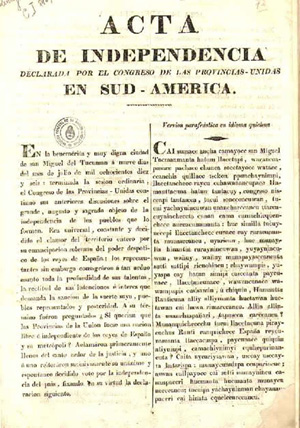
July 9, 1816 marks the declaration of Argentine independence by the Congress of San Miguel de Tucumán, a city in the northwest of the country. In reality, the congressmen who assembled in Tucumán declared the independence of the United Provinces of South America, which is still today one of the legal names of the Argentine Republic. The borders of the United Provinces did not include the Federal League Provinces in parts of what is now eastern Argentina, Uruguay and Brazil. At the same time, several provinces from Upper Peru that would later become part of present-day Bolivia were represented at the Congress.
Eight years before, in 1808, Spanish King Ferdinand VII was deposed by the Napoleonic French. The French occupation is remembered in the paintings of Francisco Goya, and in his print series “The Disasters of War,” as well as by Georges Bizet’s 1875 opera Carmen. The 1810 May Revolution started in Buenos Aires, capital of the Viceroyalty of the Río de la Plata, the Spanish colony that included roughly the territories of present-day Argentina, Bolivia, Paraguay and Uruguay. The result was the removal of the Spanish Viceroy Baltasar Hidalgo de Cisneros and the establishment of a local government, the Primera Junta (First Junta), on May 25. It was the first successful revolution in the South American independence process.
After Napoleon was defeated, the Spanish monarchy was determined to recover control over its American colonies. Royalists from Peru had been victorious at several battles in Upper Peru, and seriously threatened the United Provinces from the north. Amid political and military instability in the Río de la Plata area, a General Congress was summoned. Thirty-three delegate deputies, each representing 14,000 inhabitants, were sent from all the United Provinces of the Río de la Plata to the sessions, which started on March 24, 1816 in Tucumán. The Congress had the freedom to choose topics to debate, and endless discussions ensued.
The voting finally ended on July 9 with a declaration of independence. The Declaration, published in both Spanish and Quechua, pointed to the circumstances in Europe of the past six years – not only the removal of the king of Spain by the Napoleonic forces, but the subsequent refusal of Ferdinand VII to accept constitutional rule both at home and overseas. The declaration claimed that Spanish America recovered its sovereignty from the Crown of Castile in 1808, when Ferdinand VII had been deposed, and therefore any union between Spain and its overseas dominions had been dissolved. This was a legal concept that was also invoked by the other Spanish American declarations of independence, such as Venezuela’s in 1811 and Mexico’s in 1810, which were responding to the same events. Subsequent discussions at the Congress centered on what form of government the emerging state should adopt.
The Congress continued its work in Buenos Aires in 1817, but typically for the new governments in the New World, deep differences emerged between the Unitarian Party, who favored a strong central government, and the Federales, who favored a weak central government.
At that time the South of Argentina, Patagonia, was inhabited almost exclusively by sparsely settled Indigenous peoples. In the North, the dense pre-Columbian Quechua, Aymará and Guaraní populations made up a large percentage of the new country’s inhabitants. Beginning in the 1880s, as in the United States, large-scale immigration from Europe started transforming the ethnic character of Argentina. Over the course of a century, Argentina and its neighbor Uruguay became the most “European” nations in South America, and continued to oscillate between liberal and authoritarian government. In the 20th and 21st centuries the influences of British and U.S. neoimperialism have been felt particularly strongly.
Recognition of Argentine independence came haltingly. The first nation to recognize Argentina was the Kingdom of Hawaii in 1818, followed by Portugal in 1821, Brazil and the U.S. in 1822. Spain eventually recognized Argentina in 1857.
A few famous Argentines include Pres. Juan Domingo Perón and his wife Evita, soccer player Diego Maradona, the current Pope Francis, revolutionary Ernesto “Che” Guevara, author Jorge Luis Borges, singer-songwriters Carlos Gardel, Atahualpa Yupanqui and Mercedes Sosa.
Adapted from Wikipedia and other sources.
Photo: Declaration of Independence of the United Provinces of South America, in Spanish and Quechua

MOST POPULAR TODAY


Communist Karol Cariola elected president of Chile’s legislature

Zionist organizations leading campaign to stop ceasefire resolutions in D.C. area

Afghanistan’s socialist years: The promising future killed off by U.S. imperialism

High Court essentially bans demonstrations, freedom of assembly in Deep South






Comments